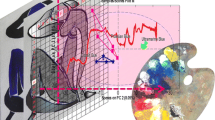Abstract
The main objective of this study is to develop computational models and algorithms for automated image-based characterization of the types of pigments used in watercolours. Pigments constitute the main element of watercolours and such studies can provide important information related to the non-destructive examination of works of art. Semi-transparent pigments are very difficult to discriminate with non-destructive methods due to the reflective properties of the substrate; computer vision techniques can complement such traditional diagnostic methods by computing models and interpreting the visual properties of the pigments used.
Similar content being viewed by others
References
M. Barni, A. Pelagotti, A. Piva, IEEE Signal Process. Mag. 22, 141 (2005)
M. Cohn, Cause and Effect in the Historical Development of Watercolour. The Broad Spectrum Studies in the Materials, Techniques and Conservation of Color on Paper (Archetype, London, 2002) pp. 62–68
R.M. Derrick, D. Stulik, M.J. Landry, Infrared Spectroscopy in Conservation Science (The Getty Conservation Institute, Los Angeles, 1999)
L. Doyle, J. Lorre, E. Doyle, Stud. Conserv. 31, 1 (1986)
O.R. Duda, E.P. Hart, G.D. Stork, Pattern Classification, No 2nd (Wiley, New York, 2000)
R. Feller, Artist’s Pigments: A Handbook on their History and Characteristics, Vol. 1 and 2 (Cambridge University Press, Cambrigde, 1986)
F. Flieder, R. Barroso, C. Oruezabal, Analysis des tannins hydrolysable susceptibles d’ entrer dans la composition des encres ferro-geliques, Comite pour la conservation de l’ ICOM, 1975
P. Goldman, Looking at Prints, Drawings, and Watercolours (The British Museum Press, London, 1994)
C.R. Gonzalez, E.R. Woods, L.E. Steven, Digital Image Processing Using MATLAB (Pearson Prentice Hall, New Jersey, 2004)
R. Jain, R. Kasturi, G.B. Schunck, Machine vision (McGraw-Hill, Singapore, 1995)
V. Kokla, A. Psarrou, A. Alexopoulou, V. Konstantinou, Computational Analysis for Conservation of Works of Art, MVA2000: IARPWorkshop on Machine Vision Applications, University of Tokyo, 2000
R. Mayer, The Artist’s Handbook of Materials and Techniques (Faber and Faber, London, 1991)
J. Lang, A. Middleton, Radiography of Cultural Materials (Butterworth-Heinemann, Oxford, 1997)
B. Ormsby, J. Townsend, B. Singer, Stud. Conserv. 50, 45 (2005)
M. Pappas, I. Pitas, IEEE Trans. Image Process. 9, 291 (2000)
M. Sonka, V. Hlavac, R. Boyle, Image Processing, Analysis and Machine Vision (Chapman and Hall, London, 1993)
J. Townsend, The Analysis of Watercolour Materials in Particular Turner’s Watercolours at Tate Gallery (1790s to 1840s). The Broad Spectrum Studies in the Materials, Techniques and Conservation of Color on Paper, Archetype, 2002, pp. 83–88
V.D. Thompson, The Materials and Techniques of Medieval Painting (Dover Publications, Dover, N.Y., 1956)
L. Xiangyang, L. Dongming, P. Yunhe, Color Restoration and Image Retrieval Techniques for Dunhuang Fresco Preservation. IEEE Multimedia 7, 38 (2000)
Author information
Authors and Affiliations
Corresponding author
Additional information
PACS
07.05.Pj; 42.30.Tz; 42.30.Va; 42.40.My; 89.20.Cf
Rights and permissions
About this article
Cite this article
Kokla, V., Psarrou, A. & Konstantinou, V. Computational models for pigments analysis. Appl. Phys. A 90, 15–22 (2008). https://doi.org/10.1007/s00339-007-4236-x
Received:
Accepted:
Published:
Issue Date:
DOI: https://doi.org/10.1007/s00339-007-4236-x




